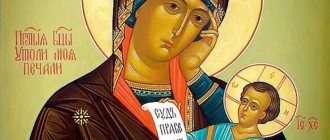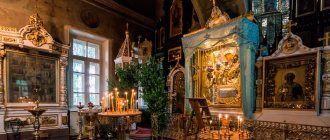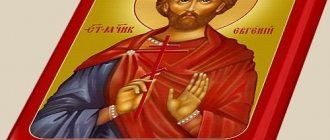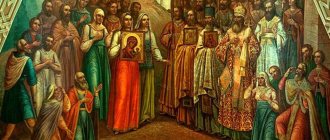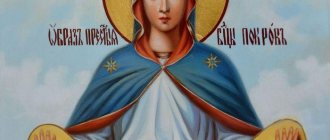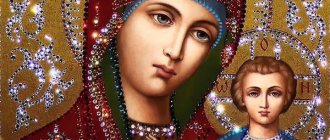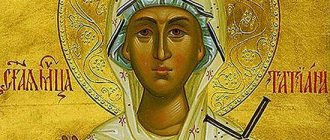| Novgorod Icon of the Mother of God “The Sign”. XII century, St. Sophia Cathedral, Veliky Novgorod. |
“The Sign,” icon of the Mother of God
Celebration November 27
The Znamenskaya Icon of the Mother of God depicts the Most Holy Theotokos sitting and raising Her hands in prayer; on her chest, against the background of a round shield (or sphere) is the blessing Divine Infant - Savior-Emmanuel.
This image of the Mother of God is one of Her very first iconographic images and inherits such ancient images as Oranta and Nikopeia. In Greece, such an image usually denoted the Nativity of Christ, and only in Russia such icons received the name “Sign,” i.e., a sign of the mercy of the Mother of God. Such icons of the Mother of God appeared in Rus' in the 12th century, and they began to be called so after a miraculous sign that occurred in 1170 from such an icon in Novgorod.
History of the icon
The image of the Most Holy Theotokos of the Sign became famous in 1170. That year, Novgorod suffered a siege from the troops of the appanage princes of Rus' under the leadership of the son of Andrei Bogolyubsky. In despair, the Novgorodians prayed to God, and on the third day, Novgorod Archbishop John heard an unearthly voice. A voice commanded him to take the icon of the Mother of God from the Church of the Transfiguration on Ilyina Street and take it to the city walls.
The archbishop fulfilled God's command, and when the image of the Queen of Heaven was carried along the city fence, the face of the Mother of God was pierced by an enemy arrow. The image of the Lady shed tears, and the Most Pure One turned her face towards the city. Horrified by what they saw, the enemy warriors seemed to go mad and began to beat each other. Inspired Novgorodians rushed into battle with renewed vigor and won.
The grateful Archbishop John established a holiday in honor of the icon of the Sign, which is still celebrated by Orthodox Christians. The day of celebration of the Icon of the Mother of God “The Sign” is December 10.
The image changed its location several times - in 1354 it was moved to the Church of the Sign of the Mother of God, in 1560 it was returned to the Transfiguration Church on Ilyin Street, to then be moved to the Cathedral of the Sign on the same street.
During the atheistic period, the icon was confiscated for museum exhibition. The ceremonial return of the shrine took place in 1991. The icon is revered by the people, especially the famous miraculous lists, named after the place of miracles:
- Vologda;
- Tsarskoselskaya;
- Solovetskaya;
- Kursk-Korennaya;
- Verkhnetagilskaya.
These icons are known not only in Russia, but also abroad.
Prayers
Troparion, tone 4
Like an insurmountable wall and a source of miracles, / having acquired Thee, Thy servants, Most Pure Mother of God, / we overthrow the resistant militias. / We also pray to Thee, / grant peace to our fatherland // and great mercy to our souls
.
Kontakion, tone 4
Come, faithful ones, let us brightly celebrate / the miraculous appearance of the all-honorable image of the Mother of God / and from this we draw grace, / let us cry out most tenderly: // Rejoice, Mary Theotokos, Mother of God, Blessed One
.
Prayer
O Most Holy and Most Blessed Mother of our Sweetest Lord Jesus Christ! We fall down and worship You before Your holy, miraculous icon, remembering the wondrous sign of Your intercession, which was revealed to the great Novegrad during the days of the military invasion of this city. We humbly pray to You, O All-Powerful Intercessor of our family: just as in ancient times You hastened to help our fathers, so now we, weak and sinners, have been made worthy of Your maternal intercession and care. Save and preserve, O Lady, under the cover of Your mercy, the Holy Church, Your city (Your abode), our entire Orthodox country and all of us who fall to You with faith and love, tenderly asking with tears for Your intercession. Hey, Madam All-Merciful! Have mercy on us, overwhelmed by many sins, stretch out Thy God-receiving hand to Christ the Lord and intercede for us before His goodness, asking us forgiveness of our sins, a pious peaceful life, a good Christian death and a good answer at His terrible Judgment, yes, we are saved by Thy almighty to Through His prayers, we will inherit the bliss of heaven and with all the saints we will sing the Most Honorable and Magnificent Name of the Most Worshipful Trinity, Father and Son and Holy Spirit, and Your great mercy to us forever and ever. Amen
.
Spiritual meaning of the icon
The Sign initially means the fulfillment of Old Testament prophecies about the imminent coming of the Savior to the world, since the Mother of God herself is the herald of the coming Messiah.
In addition, the Blessed Virgin reveals the Sign during civil strife, so that fellow believers will repent of fratricide and stop the strife. This is the paradox of such conflicts - believers in one God inevitably called on Him for help when going to war. And if those who defend themselves are heard by God, then the attackers have no excuse for their blasphemous prayers.
The Mother of God is depicted on the icon of the Sign in prayer, with her hands outstretched upward. Theologians pay attention to the canonicity of this gesture. Moses also raised his hands to heaven during the battle between the Israelites and the Amalekites, and when he weakened, Aaron and Hur supported him. The priest at the liturgy also prays with his hands outstretched to God, proclaiming “woe is our heart.”
Description and meaning
The icon depicts the Mother of God (in full height or waist-high) with her hands raised in prayer. On her chest, against the background of a shield, the baby Jesus Christ is depicted with a blessing gesture. At the behest of Elizabeth, a precious frame was made for the icon and images of the namesakes of the grandfather and father were added to the sides of the icon: the man of God Saint Alexis, the Apostle Peter. In the middle of the icon are Saints Zachary and Elizabeth.
This type of icon of the Blessed Virgin Mary is considered the very first iconographic version. A similar image was discovered in a Roman tomb dating back to the 4th century, where the Virgin Mary sits with her hands raised to the sky and the Child Jesus on her lap. In an ancient Byzantine image (VI century), the Queen of Heaven sits on a throne and holds in front of her a shield with the image of the Son of God in his infancy.
The term “Sign of the Blessed Virgin Mary” in the Orthodox tradition has two meanings: as an iconographic type and as the name of the holiday of this image. The name “Sign” came to mean “a sign of mercy from the Mother of God.”
What to ask the Mother of God before the Icon of the Sign
First of all, you need to remember that prayer is not a ritual action . The Lady requires our contrite heart. A contrite heart occurs in a person who admits that he is a sinner and that without God he is powerless. In this case, a person is able to turn to the Queen of Heaven from the heart. Bowing to the ground is a prerequisite for prayer - this is a spiritual cardio warm-up. After bowing to the ground, you can light a lamp or candle in front of the image and put incense in the censer. All this will help bring your thoughts into a calm state and prepare your soul a little. It is also important that the prayer is addressed not to the icon, but to the Mother of God depicted on it.
You should ask the Most Blessed Queen for the salvation of your soul. They turn to the image of the Sign during quarrels in the family and work collective, and during the invasion of enemies. The icon also helps stop fire, natural disasters, and pestilence.
The Icon of the Sign has the grace to heal eye diseases.
Old Believer churches in honor of the Sign of the Blessed Virgin Mary
Having been initially locally revered, the Novgorod holiday of the Sign of the Blessed Virgin Mary became all-Russian by the 16th century. He is also highly revered by Old Believers.
In 1720, the Church of the Russian Orthodox Church in Kaluga was consecrated in honor of the Sign of the Most Holy Theotokos. The church operated until 1937, and in December 1941 it found itself at the center of the battles for the liberation of Kaluga from occupation, but, thank God, it survived. During Soviet times, the temple was used as a warehouse for textile products. In March 1989, the Kaluga Regional Executive Committee granted the persistent requests of the Old Believer community to provide it with a more spacious prayer building. On March 2, 1995, the church was consecrated by His Eminence Alimpiy, Metropolitan of Moscow and All Rus'. It was decided to leave the main church in Znamensky, in honor of the Sign from the icon of the Blessed Virgin Mary in Veliky Novgorod. The chapel was consecrated in the name of St. Nicholas.
Church of the Russian Orthodox Church in the name of the Sign of the Blessed Virgin Mary in Kaluga
In the village Bobrovka, Republic of Kazakhstan, in the name of the Sign of the Most Holy Theotokos, the Church of the Russian Orthodox Church was consecrated.
Church of the Sign of the Blessed Virgin Mary. Bobrovka (RPsC)
In Orenburg there is the Znamensky Church of the Russian Orthodox Church. The brick Old Believer prayer house was transferred to the Old Believers community in 1892, after 1905 it was rebuilt. It was closed in 1931. In 1993 it was returned to the Russian Orthodox Church and repaired.
Church of the Sign of the Blessed Virgin Mary. Orenburg
In the village In Churovichi, Bryansk region, there is the Znamensky Church of the Russian Orthodox Church, built in 1870. The Russian-style temple, characteristic of this time, is an emphatically massive domed building with a cross-shaped volumetric composition and a tiered bell tower. The church building has a pentagonal apse and a cylindrical light drum with a large onion-shaped dome. A high three-tier bell tower adjoins the rectangular refectory from the west; above the center of its wide lower tier rise the quadrangle and octagon of the bell.
Church of the Sign of the Blessed Virgin Mary. Churovichi (RDC)
In honor of the Sign of the Most Holy Theotokos, the Church of the DOC in St. Petersburg, in Rybatskoe, was consecrated. The wooden church was founded on May 9, 1882 and consecrated in the name of the Kazan Icon of the Mother of God on November 1, 1883. In 1887–1889, a spacious stone vestibule with a bell tower was added to the church. At the end of the 1920s, the temple was closed, the wooden part of the temple was dismantled. Until 1961, the church building housed the warehouse of the Neva Artel. In the same year, services began. The building in 1961 was transferred to the Orthodox Old Believer community of the Bespopovtsy Pomeranian Consent. The surviving buildings were repaired and the destroyed church was partially restored, reconsecrated by the community as Znamenskaya. Since 1961, services have resumed in the church.
Church of the Sign of the Blessed Virgin Mary. St. Petersburg (DPC)
Another church of the DOC in St. Petersburg was consecrated in honor of the Sign of the Most Holy Theotokos. The church was built in 1906–1907. Old Believer community of the Pomeranian consent.
Church of the Sign of the Blessed Virgin Mary in St. Petersburg (DOC)
Miracle-working icons
The image of the Sign supplemented its glory with miracles that occurred in the 17th century. In 1611, Novgorod suffered a Swedish invasion. They robbed the houses of the townspeople and destroyed churches. Approaching the Cathedral of the Sign, the Swedes could not enter inside - an invisible wall blocked their way.
Luka Plavilshchikov, a silversmith, planned to rob the Church of the Sign in 1636. He hid in the temple for the night, stole the mug collection, liturgical vessels and approached the miraculous icon to remove the decorations and robe from the image of the Mother of God. He was thrown to the floor by an invisible hand and fell into unconsciousness. When the thief regained his sanity, he told about what had happened.
Film about the icon of the Mother of God “The Sign”
Temples in honor of the Sign of the Blessed Virgin Mary in Rus'
In the village of Grushevka, Sudak region (Crimean Peninsula), between 1361 and 1381 a church was built in honor of the Sign of the Blessed Virgin Mary. The church has an unusual appearance: a large rectangular building made of rubble stone, decorated with modest pediments, was rebuilt many times, but has preserved almost all the evidence of its centuries-old history.
Temple in honor of the Sign of the Blessed Virgin Mary in the village. Grushevka (Crimea)
In 1625, the Church of the Archangel Michael Monastery in Yuryev-Polsky . The temple occupies the southern side of the monastery courtyard and has the usual layout and design for 17th-century buildings of this type. This is a simple low temple with a spacious refectory.
Znamenskaya Church of the Archangel Michael Monastery in Yuryev-Polsky
In honor of the Sign of the Most Holy Theotokos, a temple was consecrated in Moscow, in Medvedkovo . In the fall of 1612, in the village of Medvedkovo, devastated during the Time of Troubles, a military prayer service was held before the decisive battle with the Poles for Moscow under the leadership of Dimitri Mikhailovich Pozharsky and Kuzma Minin. In memory of this event, in 1620, at the expense of Pozharsky, the first wooden tent church was erected and a memorial bell was cast for it in honor of the liberation of Moscow. In 1634-1635 In memory of his untimely deceased beloved son Fyodor, Pozharsky ordered the replacement of the wooden church with the existing stone tented church, one of the last examples of this style, since soon Nikon’s church reform banned this type of religious buildings as “not corresponding to the rank.”
Church of the Sign in Moscow, in Medvedkovo
In Moscow on Znamenka there was a temple in the name of the Sign of the Blessed Virgin Mary. The first mention of the temple dates back to the beginning of the 17th century, during the interrogation of followers of False Dmitry. It is also known that one of the church bells had the inscription “alms from the parish people”, which appeared in 1600. The Znamenskaya Church was located on the corner of Znamenka Street and Bolshoy Znamensky Lane (Znamenka, vl. 17), which were named after this church. The temple became stone in 1646, later rebuilt in 1657, and the bell tower itself was erected ten years later. In 1929, the church was closed, and two years later it was completely destroyed.
Znamensky Church in Moscow
In honor of the Sign of the Most Holy Theotokos, the altar of the Church of the Nativity of the Virgin Mary in Volokolamsk (1535), the Church of St. Nicholas in Kolomna (circa 1530), the Church of St. Nicholas in Pskov (1500) and the St. Nicholas Church in the village were consecrated. Upper Bridge of the Pskov region (1450).
